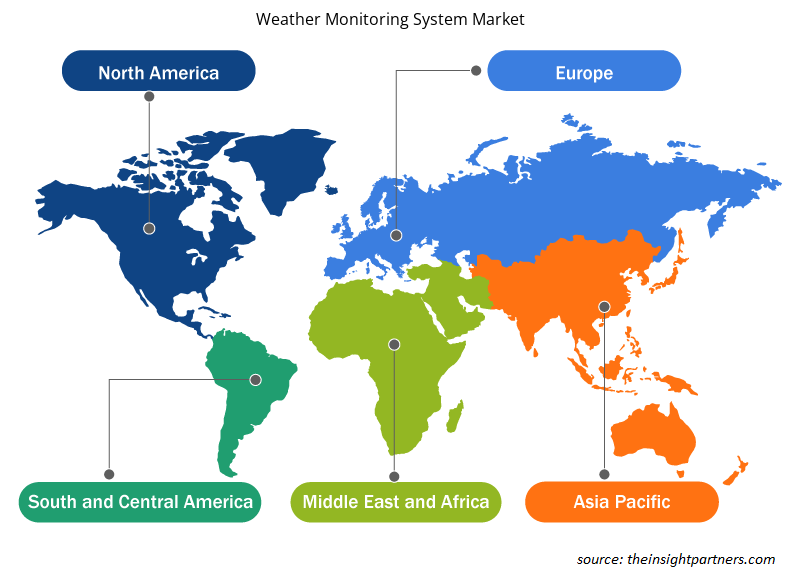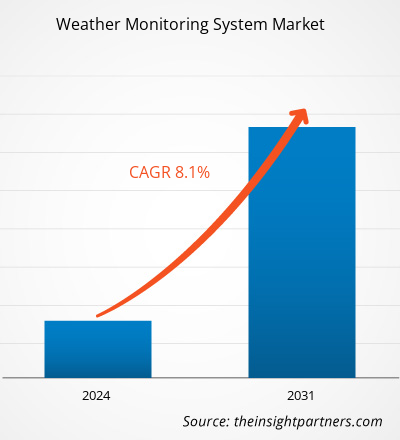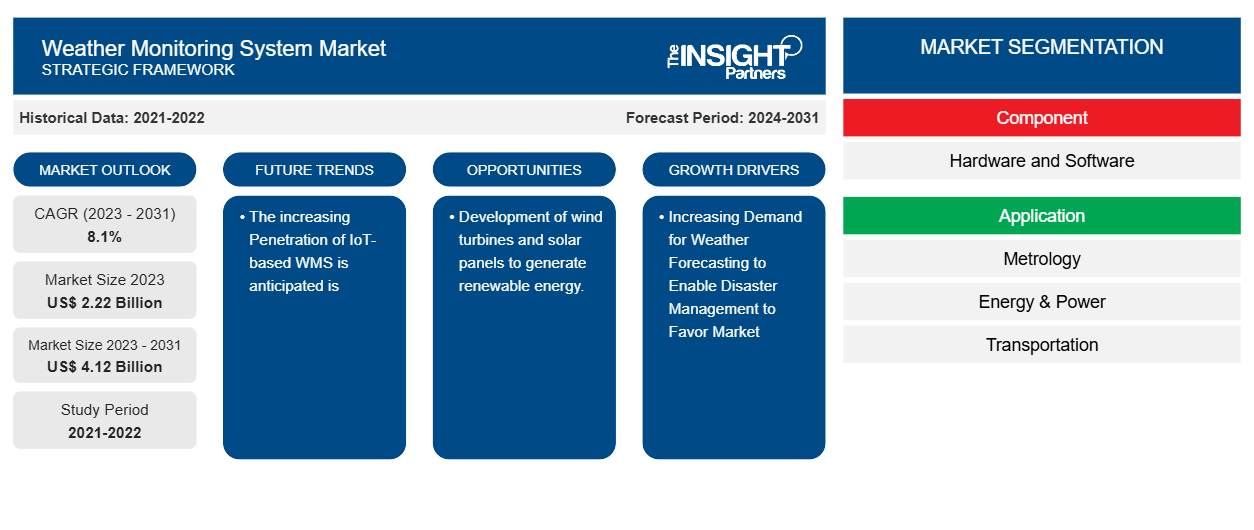Se proyecta que el tamaño del mercado de sistemas de monitoreo meteorológico (WMS) alcance los 4.120 millones de dólares estadounidenses en 2031, frente a los 2.220 millones de dólares estadounidenses en 2023. Se espera que el mercado registre una CAGR del 8,1 % durante el período 2023-2031. Es probable que el uso cada vez mayor de la previsión meteorológica para permitir la gestión de desastres y la creciente demanda de previsión meteorológica en la industria de la aviación sean tendencias clave y factores impulsores en el mercado de sistemas de monitoreo meteorológico.
Análisis del mercado de sistemas de monitoreo meteorológico
El mercado de sistemas de monitoreo del clima está experimentando un crecimiento sustancial a nivel mundial. Este crecimiento se atribuye al patrón de cambio climático que genera incertidumbres en el clima y al uso creciente de pronósticos meteorológicos para permitir la gestión de desastres. Además, el aumento en la producción de energía renovable, el aumento de las capacidades informáticas de las supercomputadoras para el pronóstico del tiempo y la creciente penetración de WMS basados en IoT.
Descripción general del mercado de sistemas de monitoreo meteorológico
La vigilancia o el análisis continuo o periódico del estado del clima y la atmósfera, incluidas variables como la temperatura, la humedad, la velocidad del viento y la presión barométrica. Además, los sensores de temperatura y humedad son los sensores meteorológicos más utilizados. Se pueden utilizar para calcular un índice de calor, comprender si las plantas corren el riesgo de sufrir daños por exceso de calor o determinar si es seguro trabajar en una zona determinada.
Personalice este informe según sus necesidades
Obtendrá personalización en cualquier informe, sin cargo, incluidas partes de este informe o análisis a nivel de país, paquete de datos de Excel, así como también grandes ofertas y descuentos para empresas emergentes y universidades.
-
Obtenga las principales tendencias clave del mercado de este informe.Esta muestra GRATUITA incluirá análisis de datos, desde tendencias del mercado hasta estimaciones y pronósticos.
Factores impulsores y oportunidades del mercado de sistemas de monitoreo meteorológico
La creciente demanda de pronósticos meteorológicos para facilitar la gestión de desastres favorece el mercado
La creciente demanda de pronósticos meteorológicos para facilitar la gestión de desastres es, sin duda, un factor impulsor del mercado de sistemas de monitoreo meteorológico. Los monitores/estaciones meteorológicas sirven como herramientas fundamentales en la preparación y respuesta ante desastres. Al proporcionar datos meteorológicos precisos y oportunos, estos monitores empoderan a las personas, las comunidades y las autoridades para planificar, mitigar los riesgos y responder de manera eficiente a las catástrofes. Las estaciones meteorológicas actúan como puente entre las observaciones meteorológicas y la gestión de desastres, fomentando sociedades más seguras y resilientes. A medida que la tecnología continúa avanzando, la adopción de enfoques innovadores e integración de nuevas capacidades fortalecerá el papel de las estaciones meteorológicas en el futuro de la gestión de desastres. Por lo tanto, considerando los parámetros anteriores, el uso creciente de pronósticos meteorológicos para facilitar la gestión de desastres está actuando como uno de los impulsores del crecimiento del mercado de sistemas de monitoreo meteorológico.
Desarrollo de turbinas eólicas y paneles solares para generar energía renovable.
Un WMS es uno de los componentes clave de una planta de energía solar. Su función es recopilar datos sobre parámetros meteorológicos como la temperatura de la superficie del módulo, la radiación solar, la temperatura ambiente, la velocidad del viento, etc., en cualquier sitio de energía solar fotovoltaica, lo que ayuda a monitorear la eficiencia y el rendimiento de la planta de energía. El análisis posterior de estos datos con respecto a la salida de la planta ayuda a analizar y mejorar el rendimiento de la planta. Además, para la medición de datos meteorológicos de la estación de energía eólica , la estación meteorológica basada en el registrador de datos SmartSolo se instala en la torre meteorológica permanente para medir la velocidad y la dirección del viento a dos alturas, así como la temperatura, la humedad relativa y la presión del aire. Por lo tanto, debido a los parámetros anteriores, se anticipa que el desarrollo de turbinas eólicas y paneles solares para generar energía renovable brindará varias oportunidades para el mercado de sistemas de monitoreo meteorológico en los próximos años.WMS is one of the key components in a solar power plant. Its function is to collect data on weather parameters such as module surface temperature, solar radiation, ambient temperature, wind speed etc., at any solar PV site, which assists in monitoring the efficiency and performance of the power plant. The further analysis of this data w.r.t the plant output helps to analyze and improve the performance of the plant. Moreover, for the weather data measurement of the SmartSolo data logger is installed on the permanent weather tower to measure the wind speed and direction at two heights, as well as the temperature, relative humidity and air pressure. Thus, owing to the above parameters, the development of wind turbines and solar panels to generate renewable energy is anticipated to hold several opportunities for the weather monitoring system market in the coming years.
Análisis de segmentación del informe de mercado de sistemas de monitoreo meteorológico
Los segmentos clave que contribuyeron a la derivación del análisis del mercado del Sistema de Monitoreo Meteorológico son los componentes y la aplicación.
- Según los componentes, el mercado de sistemas de monitoreo meteorológico se divide en hardware y software. Se prevé que el segmento de hardware ocupe una participación de mercado significativa en el período de pronóstico.
- Por aplicación, el mercado se segmenta en metrología, energía y electricidad, transporte, aviación y otros. Se prevé que el segmento de metrología ocupe una cuota de mercado significativa en el período de pronóstico.metrology, energy & power, transportation, aviation, and others. The metrology segment is anticipated to hold a significant market share in the forecast period.
Análisis de la cuota de mercado de los sistemas de vigilancia meteorológica por geografía
El alcance geográfico del informe de mercado del sistema de monitoreo meteorológico se divide principalmente en cinco regiones: América del Norte, Asia Pacífico, Europa, Medio Oriente y África, y América del Sur y Central.
El mercado de sistemas de monitoreo meteorológico en América del Norte ha dominado. El mercado de América del Norte está segmentado en Estados Unidos, Canadá y México. Las tendencias de adopción de alta tecnología en varias industrias en la región de América del Norte han impulsado el crecimiento del mercado de sistemas de monitoreo meteorológico. Factores como la mayor adopción de herramientas digitales, el alto gasto tecnológico por parte de las agencias gubernamentales y el patrón de cambio climático en la región están generando incertidumbres en el clima, y se espera que el uso creciente de pronósticos meteorológicos para permitir la gestión de desastres impulse el crecimiento del mercado de sistemas de monitoreo meteorológico en América del Norte. Además, un fuerte énfasis en la investigación y el desarrollo en las economías desarrolladas de los EE. UU. y Canadá está obligando a los actores norteamericanos a traer soluciones tecnológicamente avanzadas al mercado. Además, Estados Unidos tiene una gran cantidad de actores del mercado de sistemas de monitoreo meteorológico que se han centrado cada vez más en el desarrollo de soluciones innovadoras. Todos estos factores contribuyen al crecimiento del mercado de sistemas de monitoreo meteorológico en la región.
Perspectivas regionales del mercado de sistemas de monitoreo meteorológico
Los analistas de Insight Partners explicaron en detalle las tendencias y los factores regionales que influyen en el mercado de sistemas de monitoreo meteorológico durante el período de pronóstico. Esta sección también analiza los segmentos y la geografía del mercado de sistemas de monitoreo meteorológico en América del Norte, Europa, Asia Pacífico, Medio Oriente y África, y América del Sur y Central.

- Obtenga datos regionales específicos para el mercado de sistemas de monitoreo meteorológico
Alcance del informe de mercado de sistemas de monitoreo meteorológico
| Atributo del informe | Detalles |
|---|---|
| Tamaño del mercado en 2023 | US$ 2.22 mil millones |
| Tamaño del mercado en 2031 | 4.120 millones de dólares estadounidenses |
| CAGR global (2023 - 2031) | 8,1% |
| Datos históricos | 2021-2022 |
| Período de pronóstico | 2024-2031 |
| Segmentos cubiertos |
Por componente
|
| Regiones y países cubiertos |
América del norte
|
| Líderes del mercado y perfiles de empresas clave |
|
Densidad de actores del mercado de sistemas de monitoreo meteorológico: comprensión de su impacto en la dinámica empresarial
El mercado de sistemas de monitoreo del clima está creciendo rápidamente, impulsado por la creciente demanda de los usuarios finales debido a factores como la evolución de las preferencias de los consumidores, los avances tecnológicos y una mayor conciencia de los beneficios del producto. A medida que aumenta la demanda, las empresas amplían sus ofertas, innovan para satisfacer las necesidades de los consumidores y aprovechan las tendencias emergentes, lo que impulsa aún más el crecimiento del mercado.
La densidad de actores del mercado se refiere a la distribución de las empresas o firmas que operan dentro de un mercado o industria en particular. Indica cuántos competidores (actores del mercado) están presentes en un espacio de mercado determinado en relación con su tamaño o valor total de mercado.
Las principales empresas que operan en el mercado de sistemas de monitoreo meteorológico son:
- Vaisala
- Toque de trinidad
- Trafitek Soluciones Privadas Ltd.
- Telegrafía como
- Sistemas de detección de rayos Boltek
- Espíritus libres Green Labs Pvt Ltd
Descargo de responsabilidad : Las empresas enumeradas anteriormente no están clasificadas en ningún orden particular.

- Obtenga una descripción general de los principales actores clave del mercado de sistemas de monitoreo meteorológico
Noticias y desarrollos recientes del mercado de sistemas de monitoreo meteorológico
El mercado de sistemas de monitoreo meteorológico se evalúa mediante la recopilación de datos cualitativos y cuantitativos a partir de investigaciones primarias y secundarias, que incluyen publicaciones corporativas importantes, datos de asociaciones y bases de datos. A continuación, se enumeran algunos de los avances en el mercado de sistemas de monitoreo meteorológico:
- El 11 de abril, un cohete Falcon 9 de SpaceX lanzó un satélite de monitoreo meteorológico de la Fuerza Espacial de EE. UU. (Fuente: sitio web de la empresa SpaceX, abril de 2024)
- La Organización de Investigación Espacial de la India (Isro) lanzó con éxito el INSAT-3DS, un satélite de vigilancia meteorológica y alerta de desastres. El satélite fue lanzado a bordo del cohete GSLV-F14 desde Sriharikota. (Fuente: ISRO, comunicado de prensa, febrero de 2024)
Informe de mercado sobre sistemas de monitoreo del clima: cobertura y resultados
El informe “Tamaño y pronóstico del mercado de sistemas de monitoreo meteorológico (2021-2031)” proporciona un análisis detallado del mercado que cubre las siguientes áreas:
- Tamaño y pronóstico del mercado de sistemas de monitoreo meteorológico a nivel global, regional y nacional para todos los segmentos clave del mercado cubiertos por el alcance.
- Tendencias del mercado de sistemas de monitoreo meteorológico, así como dinámica del mercado, como impulsores, restricciones y oportunidades clave.
- Análisis detallado PEST/Cinco fuerzas de Porter y FODA.
- Análisis del mercado del sistema de monitoreo meteorológico que cubre las tendencias clave del mercado, el marco global y regional, los principales actores, las regulaciones y los desarrollos recientes del mercado.
- Análisis del panorama de la industria y la competencia que cubre la concentración del mercado, el análisis de mapas de calor, los actores destacados y los desarrollos recientes para el mercado de sistemas de monitoreo meteorológico.
- Perfiles detallados de empresas.
- Análisis histórico (2 años), año base, pronóstico (7 años) con CAGR
- Análisis PEST y FODA
- Tamaño del mercado, valor/volumen: global, regional y nacional
- Industria y panorama competitivo
- Conjunto de datos de Excel
Informes recientes
Testimonios
Razón para comprar
- Toma de decisiones informada
- Comprensión de la dinámica del mercado
- Análisis competitivo
- Información sobre clientes
- Pronósticos del mercado
- Mitigación de riesgos
- Planificación estratégica
- Justificación de la inversión
- Identificación de mercados emergentes
- Mejora de las estrategias de marketing
- Impulso de la eficiencia operativa
- Alineación con las tendencias regulatorias























 Obtenga una muestra gratuita para - Mercado de sistemas de monitoreo meteorológico
Obtenga una muestra gratuita para - Mercado de sistemas de monitoreo meteorológico